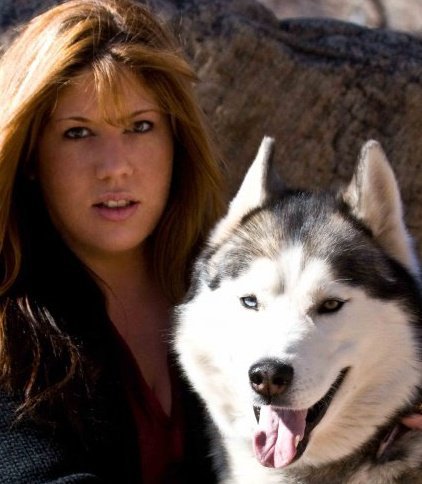
 JAMES STRECKER: In what specific ways has COVID-19 changed your creative/artistic life in the arts?
JAMES STRECKER: In what specific ways has COVID-19 changed your creative/artistic life in the arts?
ELYSE DRAPER: As a creative person, I spend most of my time in my head, where I can ride the waves of imagination back to dry land and coherent ideas. Most of us artistic types are a funky mix of extroverted introverts, showing our most vulnerable parts in our artwork for inspection by the general populous, while hiding under our respective blankets to avoid eye contact. We are already used to a certain amount of isolation… that isn’t to say that we don’t miss going out and socializing. For us, I believe the stir craziness isn’t as much of an issue when the means of escape can be found in a good book or pigment spread on canvas. All of this to say, the virus and resulting quarantine has not hampered the creative spirit; however, the houseful of fellow detainees, who are painfully exuberant with their stir craziness, are a bit of a distraction.
JS: How creative are you feeling with COVID-19 on your mind?
ED: My prominent form of creative expression is found in writing, in particular dark fiction and/or speculative fiction. The virus, for me, is more of an inspiration than an obstruction. Watching human nature play out in all of its brutal glory provides more subject matter than I know what to do with … the only ones finding a more compelling muse during this time are comedians and humorists.
JS: In what specific ways has COVID-19 changed your personal life?
ED: I have spent the last nine years attempting to understand the auto-immune disease that is presently, progressively, and quite painfully robbing me of my eyesight. In particular, I have spent the last six years on high doses of immunosuppressant medications, simply trying to slow the advancement of the disease. I have been dealing with a severely compromised immune system for long enough now that not much has changed from my personal perspective. Any highly communicable illness is a threat to my life; therefore, I have been aware of what precautions to take in order to try and stay healthy for quite some time. My family has been with me through this learning curve; and as a result, they take remarkable care of themselves. Knowing that they are healthy, and in turn keeping their friends healthy, removes virtually all fear. At a certain point, without fear or panic there is an acceptance of how fragile life is, but one cannot stop living; thus, one takes their safety measures and makes the appropriate concessions, while finding creative ways to grab life by the ear and drag it into submission.
It is important to remember that Sisyphus’s punishment of eternally pushing a boulder uphill, the crushing defeat of having physical freewill taken away, the hopelessness that follows … is a myth. As long as our minds are free, so is our will. The creative mind is particularly free during trying times such as this; whether inspired through fear or fascination, we are the fortunate ones.
JS: What are your primary worries, at this time, about the present situation in the arts because of COVID-19?
ED: I believe that there are three major facets to the arts, in economics and thus social importance in a capitalist society; and only one as far as its existential importance. Economically, there are the sponsors, the producers, and the consumers. Whereas existentially, art in all of its vast mediums is the manifestation of humanity’s creativity, the physical expression of the creatures of imagination and introspection … and thus holds mankind’s ability to not only understand the world around them and within them, but to tangibly tap into our universal subconscious connections, where we remember how to heal through the simple thought, “I am not alone.”
At times such as this, where the economy is in a downward spiral, the arts become a target (even more so than at times of prosperity) for those who do not appreciate its existential importance, and thus deem it non-essential. These are the shallow thinkers in positions of power and influence, cutting the fat, as it were … thus the sponsors and consumers follow suit to focus on fundamental survival needs- food, shelter, water (and apparently toilet paper.) Understandably, it can be a disheartening turn for the artistic producer, and anxiety for the existence of the arts becomes unavoidable.
However, we must remember that no matter who seemingly believes in the non-essential nature of the arts, it is an existential societal necessity, especially during hard times to serve as a reminder that we are in this together. The imaginative mind does not stop creating because it is told that the act is frivolous … much like a hawk does not stop gliding because it is told that only ‘real birds’ flap their wings. We are what we are; we do what we do whether we have an audience or not; and the arts themselves cannot be extinguished, while artists exist. Therefore, take heart – Art is a mean old immortal bastard, virulent with sharper teeth than any critic or disease.
JS: What are your primary worries about the future situation in the arts because of COVID-19?
ED: Economically, artists will have to become more inventive with their earning potential, and broaden their skill sets until there is a resurrection of the trade. We are imaginative folks, after all.
Throughout history, the arts’ popularity ebbs, and flows, but always resurfaces because of its fundamental importance to humanity’s collective psyche. The arts will survive. It survived the fall of the Library of Alexandria, Great Famine and Black Death, The Third Reich, and Kanye West … it will survive COVID-19 as well.
JS: What are you yourself doing to get through this time of crisis?
ED: I have become more inventive with my earning potential and broadened my skill set… I should probably add that I have been doing so over the past two years, going blind tends to make one become imaginative with their future earning potential. I own and operate a graphic design- branding and merchandising company that is also a graphic t-shirt internet boutique. Small businesses are being hit particularly hard with the quarantine; however, we are still stable-ish as an internet company, for now. Consumer spending is decreasing exponentially, and marketing has become secondary to keeping a businesses’ doors open – so, everyone is feeling the strain equally.
Through the pressure though, my partner and I realized that we could help to bolster our neighbors’ businesses rather than curse our circumstances. We have spent the last month of quarantine building two campaigns-
1.) Our boutique is selling two discounted shirts, at $15 each, 50% of each sale is being donated to #GetUsPPE to help our medical community stay safe.
1.) FEELING HELPLESS? WHAT YOU CAN DO DURING THE CORONAVIRUS CRISIS: A SMALL BUSINESS’S REMEDY DURING COVID-19 – PART ONE
2.) We created a stimulus marketing proposal to help our local foodservice businesses and their employees, and it also translates into helping other small businesses. We are offering merchandise at cost, apparel printing for free, and graphic design creations at an extreme discount. The hope is to help our local restaurants, bars and taverns, distilleries and breweries create a separate, affordable, merchandising platform to bring in another avenue of income. We are also opening up our internet boutique to promote their merchandise, with direct links back to their points of sale- websites and/or take out menus. In keeping our prices incredibly low, the sellers can also provide sale prices to their customers, thus addressing the decrease in consumer spending. This is a twofold plan, it helps with sales now, and maintains marketing (in wearable stylish billboards) after the quarantine restrictions have been lifted.
2.) BUSINESSES HELPING BUSINESSES, A STIMULUS PROPOSAL TO HELP OUR LOCAL FAVORITE HAUNTS A Small Business Response to the Covid 19 Crisis-Part Two
JS: What are other creative/artistic people you know doing to get through this time of crisis?
ED: We are creative/artistic inventive individuals … most of my friends and co-conspirators are recreating themselves to fit their needs.
JS: What are the saddest stories you’ve heard about creative/artistic people during this time of COVID-19?
ED: We are also intuitive emotional souls … there are too many stories of the anxiety, and foreboding, translating into self-deprecation, and a general feeling of inadequacy.
JS: What are the most encouraging or inspiring stories you’ve heard about creative/artistic people during this time of COVID-19?
ED: I believe that when we look at our creative intuitive friends, the most inspiring stories come from their overcoming their own anxieties, their own inadequacies, to embrace supporting one another and sharing compassion and humor. This is an overwhelming, and heartening trait within our community; we couldn’t ask for anything more encouraging than that.
JS: How can we support people in the arts during this difficult time?
ED: Never stop sponsoring, purchasing, and promoting your favorite artists. Inspire infectious conversations about how their pieces have stirred your soul or spoken to your subconscious in healing whispers. Allow the arts to continue to feed the seeds of imagination and insight.
JS: Finally, what specifically can we do to support your life and work in the arts?
ED: Find my work and pass on your impressions. Amazon Author Page. Tell your favorite small businesses about The Hall Closet Custom Shirtworks’ stimulus plan. Continue to support the arts in general, for it feeds us all.
